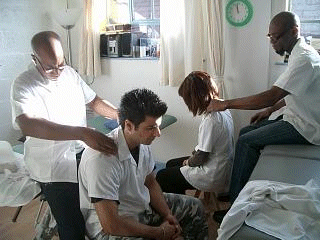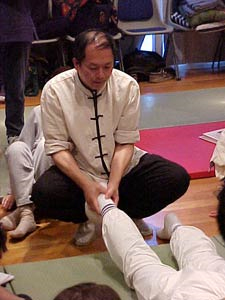Tui Na Massage
Tui Na (pronounced ‘twee-nah’) massage is a complete healing system, like acupuncture and Chinese herbal medicine. These three forms of therapy are the main components of Traditional Chinese Medicine (TCM). Tui Na is probably the oldest system of bodywork still practiced yet its popularity continues to grow.
The techniques of Tui Na and details of its uses in treating a range of health problems were already documented in a vast treatise – The Yellow Emperor’s Classics of Internal Medicine, written about 2500 years ago. After such a lengthy period of development and evolution, modern Tui Na is the most tried and tested hands-on therapy in the world.

How is it done?
Tui Na is applied to the clothed body. Patients sit on a chair or lie on a couch. Be prepared to answer some questions about your state of health before having a Tui Na treatment.
How does it work?
Tui Na works in accordance with the complex theory of TCM. Fundamental to this theory is the life powering energy that the Chinese call Qi (pronounced ‘chee’). Every aspect of bodily function depends upon Qi and its flow through the tissues.
The Chinese recognize a network of 12 paired meridians – one member of each pair on the right side of the body and the other on the left. There are also two unpaired meridians that encircle the trunk and the head in the mid-line.
These meridians are not like vessels, they have no anatomical structure but they are pathways along which the main flow of Qi occurs. It is best to visualize them as precise currents of Qi, just like currents of water in the oceans.
Interestingly, Western scientific methods have been used to plot the courses of these meridians, and they confirm the accuracy of detailed maps produced around the time of The Yellow Emperor’s Classics of Internal Medicine.
At irregular intervals along the meridians there are specific Qi points (the acu-points of acupuncture) where pressure, needles or heat can affect the way Qi flows through the meridian. This effect can manifest itself on some part of the meridian quite distant from where the stimulus is applied.
When Qi flow is disturbed anywhere in the body, Qi imbalance that results can cause pain, stiffness, sickness – even emotional pain.
The Chinese believe that health and vitality depend on Qi balance in the body. Tui Na is one of the best ways of achieving this and it uses an array of techniques to do it.
A Casual observer watching a session sees what appears to be a thorough workout for the soft tissues and joints, but the practitioner aims to do more than this. Attention is focused on meridians and selected Qi points. They are massaged in different ways to remove all blockages to the flow of Qi.

Tui Na has a variety of different systems that emphasize particular aspects of these therapeutic principles. The main schools in China include the rolling method school which emphasizes soft tissue techniques and specializes in joint injuries and muscle sprains, the one finger pushing method school which emphasizes techniques for acupressure and the treatment of internal diseases, the Nei Gung method school which emphasizes the use of Nei Gung Qi generation exercises and specific massage methods for revitalizing depleted energy systems, and the bone setting methods school which emphasizes manipulation methods to realign the musculo-skeletal and ligamentous relationships and specializes in joint injuries and nerve pain. In addition to these four main schools, there are hundreds of “family systems” that have been passed on from generation to generation and utilize aspects of each major system.
What does it treat?
Tui Na treats chronic pain, especially that caused by muscle-skeletal conditions and injuries. Neck, shoulder and back pain and immobility, sciatica and ‘tennis elbow’ all respond very well.
It is, however, impossible to treat a specific condition with Tui Na without improving the overall Qi status of the body.
This means that headaches, migraines, IBS, constipation, PMS and a whole range of emotional problems can also be treated.
In China , Tui Na is used for conditions that, in the West, would be treated by osteopaths, chiropractors and physiotherapists or with drugs.
What does it feel like?
It is a very vigorous massage; every technique requires movement as well as pressure, After the first session you may feel a little sore but after two or three more most people adjust to the deep pressure.
Depending on the type of Tui Na treatment you have, you might leave feeling a bit light headed. Some patients experience sleepiness while others feel supercharged. Almost always, everyone feels better after Tui Na.
Any side effects?
As with acupuncture, Tui Na produces many side effects, but all of them are positive.
A common example is the person treated for chronic back pain finding that their chronic constipation has also been eased. This is because the pain treatment focuses on the Bladder meridian which links directly into the Qi energies of the large intestine.
Sometimes side effects can be very emotional and patients feel like crying uncontrollably.
Are there contra-indications?
Yes. As with all forms of therapy, there are certain conditions that would contra-indicate Tui Na but very few would contra-indicate it completely.
Very deep, soft tissue massage and vigorous join manipulations would be inappropriate for someone with osteoporosis and so would direct massage on skin affected by eczema or infection, to mention just two examples. Even in these cases, however, it might be possible to do very effective Tui Na using distinct parts of the meridians and selected distant Qi-points.
How to train
There are very few professional courses in Tui Na and they vary in length and content. Before choosing a course, check its content; it should include basic Traditional Chinese Medical theory and relevant anatomy and physiology.
It should also train students to treat the chronic muscular-skeletal problems for which Tui Na is so effective. To be able to deeply apply the techniques accurately to the meridians and acu-points without injury requires thorough training. It’s impossible to learn Tui Na in a weekend or a few days.
